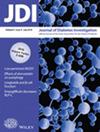Monocyte–lymphocyte ratio predicts cardiovascular diseases death in individuals with type 2 diabetes
Abstract
Purpose
Previous studies have shown higher cardiovascular mortality risk with higher monocyte–lymphocyte ratio levels in general population. However, the levels of oxidative stress in individuals with type 2 diabetes are higher than those in the general population, which may affect the link between monocyte-to-lymphocyte ratio and cardiovascular disease deaths. And the association between the monocyte-to-lymphocyte ratio and mortality risk in people with type 2 diabetes still be unknown. This study aimed to investigate the prognostic significance of monocyte-to-lymphocyte ratio in type 2 diabetes.
Methods
This analysis involved 2,954 individuals with type 2 diabetes from the National Health and Nutrition Examination Survey 1999–2010. The National Death Index records through December 31, 2019, was used to determine all-cause and cardiovascular mortality. The prognostic roles were determined using Cox regression models, restricted cubic spline analysis, and time-dependent receiver operating characteristic curve analysis.
Results
During an average follow-up period of 12.4 years, a total of 1,007 deaths occurred, while 252 were due to cardiovascular disease. An elevated monocyte-to-lymphocyte ratio level exhibited a significant dose–response relationship with an increased risk of all-cause mortality (1.34 [95% CI 1.12, 1.60] for all-cause mortality [P trend = 0.001]). The multivariable-adjusted HR was 1.81 (95% CI 1.25, 2.63) (P trend = 0.001) for cardiovascular mortality indicating a U-shaped relationship (P nonlinear = 0.013).
Conclusions
The results of this study indicate a U-shaped relationship between the monocyte-to-lymphocyte ratio and cardiovascular mortality in individuals with diabetes. Both very low and high monocyte-to-lymphocyte ratio monocyte-to-lymphocyte ratio values were found to be associated with increased cardiovascular mortality risk.


 求助内容:
求助内容: 应助结果提醒方式:
应助结果提醒方式:


